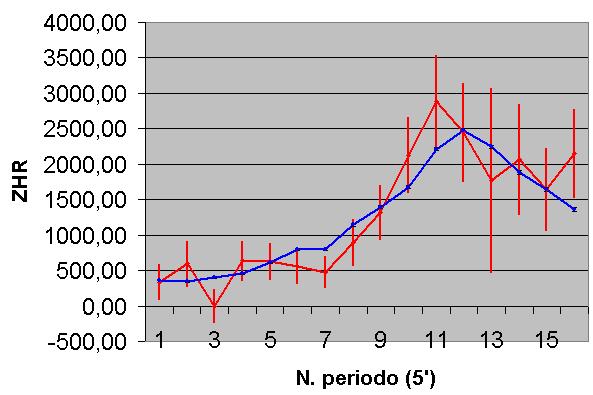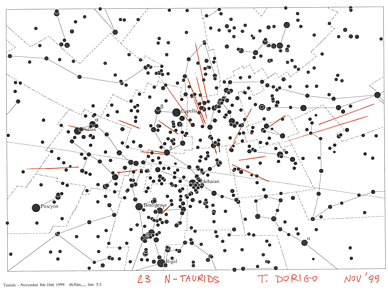 Comet Swift-Tuttle (left, courtesy NASA) may be far away by now, but the debris that gets thrown out in space during each of its passages in the proximity of our Sun traces the full elliptical orbit of the comet, like droplets of sweat of an athlete running the 10,000 meters in a stadium. And tonight, the Earth is going to plunge in the core of the filament of debris following the comet's orbit.
Comet Swift-Tuttle (left, courtesy NASA) may be far away by now, but the debris that gets thrown out in space during each of its passages in the proximity of our Sun traces the full elliptical orbit of the comet, like droplets of sweat of an athlete running the 10,000 meters in a stadium. And tonight, the Earth is going to plunge in the core of the filament of debris following the comet's orbit.Have you ever looked up during a thunderstorm, to get hit in the face by raindrops lit by thunder, after realizing you are soaking wet and you might as well enjoy the show? If you have, you may have discovered that the raindrops appear to "radiate" from a particular point of space. You basically see the same kind of image as the one Hollywood directors have figured would be what you experience during a jump above light speed.
Watching a meteor storm is not any different, although this time the kinematics is not so simple as in the thunderstorm example. Both the Earth and the meteoroids move, in different directions. What's worse, each of the meteoroids moves in random directions within their "envelope", the filament following the comet's orbit. Despite the random motion and the combination of speeds, what you see is easy to describe: meteors appear to radiate from the same point of space. The only difference is that they "light up" at different points along the virtual trajectories radiating off the common vertex.
The light-up and fade-off points happen at altitudes of about 105 to 85 kilometers, but the exact points from a visual observer on the ground depend on several details. Larger bits of stardust start burning slightly earlier, and make longer, brighter streaks. Ones hitting our upper atmosphere tangentially will make the longest streaks of all, while ones hitting us head-on will appear to light up exactly at the vertex of the shower. But there is much more to see than a streak of light: the meteor may appear to be slow or blitzing fast, it may be coloured, leave a persistent smoky trail, show flares, fragment into several bits. In certain occasions sounds may be heard (with a long delay). The variability of these characteristics, and the commonalities among meteors from the same stream, make each meteor shower a unique event.
Among the characteristics which are most studied of a shower, one is its frequency profile in time -id est, the rate of meteors that can be seen per hour. Our perception of the rate of meteors hitting the Earth is affected by many factors: the height of the radiant point above the horizon, the darkness of the sky, the absence of mist or clouds; the true rate instead only depends on the density of meteoroids in the point where the Earth crosses the comet's orbit.
Most meteor streams only deliver a few meteors per hour, and their variability, together with the lack of observational data, prevents scientists from making definite predictions on the future events. The Perseids are instead rightly famous for delivering faultlessly. the density profile of their filaments are well-modeled by simulations, and their forecast is usually precise. But they are not the most intense shower. For instance the Leonids, peaking on November 19th, at times provide real "meteor storms", as was the case during the years 1998 to 2003.
I was lucky enough to observe two of these occurrences, once on a intercontinental flight from the US to Europe, on November 17th 1999, during which I counted 403 tracks in two hours spent squashing my nose against the window; and in another occasion when I traveled 450 kilometers (and back) to find the only place not covered by clouds in Italy. On that occasion I saw over 500 meteors, and recorded almost 200 tracks on digital camera. I can offer a few video clips below, which show dozens of bright streaks captured close to peak time of the 2002 shower, in less than a minute. The rate during the peak time (which only lasted a few minutes) was so high I could count almost a meteor every couple of seconds!
Other clips you might like to have a look at:
- 03 A: Two bright tracks (a short one of Mv=-2.5, the other of Mv=0) appear northwest of Leo in the matter of two seconds;
- O3 B: A moon-class fireball unfortunately out of the field of view yields a bright flare illuminating the scenery, and is followed by three more zero-magnitude tracks in Orion in the matter of 7 seconds.
- 03 C: A track in Orion is followed by another perfectly aligned with it one second afterwards.
From the data collected with the webcam, I later computed the rate of Leonids as a function of time. You can see my results below, compared with the data obtained from hundreds of observations by the International Meteor Organization.

In the plot, the vertical axis is the zenith hourly rate, and the horizontal axis is the time series, in five-minute intervals, around the peak time of the shower. The blue curve is the IMO result, and the red one shows my measurements. I fared pretty well!
Now, I would not like to deceive you. Determining the true Zenith Hourly Rate (the empirical number measured from the ground by observers, corrected for all the factors affecting their observation) from the number of meteors seen as a function of time is not an easy matter, since it requires some careful evaluations, a little trigonometry and math, and crucially, some fiddling with hypotheses on the relative number of faint and bright meteors -a parameter depending on the shower, which is not known a priori and can be obtained through measurement only with additional analysis of the brightness distribution. Of course, science is always hard, just as sex is always dirty, if they are done correctly. But fear not: you can still make a contribution to planetary science tonight, if you are armed with patience, and if the sky above your head is reasonably clean and dark.
All you should do is go to a place far from light sources, with good visibility above your head, and take with you warm clothes, a reclining chair, a watch, and a recorder. Then, lie back and watch the sky, aiming at a height of about 60 degrees above the horizon. Every time you see a meteor, if you think it is coming from Perseus (most of the meteors you see tonight will), you may record the universal time (UT) (hours, minutes, seconds) at which you saw the meteor. If you are good, you may try to estimate its visual magnitude (brightness) by comparing it to known stars you see in the sky. If you are very good, you may want to add details such as the colour, the speed in degrees per second, the duration in seconds, and the location in the sky. If you are a real expert you may want to take a few seconds to draw the streak on a gnomonic projection map of the sky. What you will end up drawing at the end of a long night might resemble this map:

In the case shown above, the 23 red tracks I recorded belong to another stream, the northern Taurids. However, you got the idea...
There are a few additional details you should be aware of. You should be able to estimate every 15 minutes or so, at least roughly, the magnitude of the faintest stars you can see. This is easier than it looks, since there now exist several computer maps of the night sky which provide all the data you need. Another important datum, in the absence of which the ZHR cannot be computed, is the fraction of your field of view which is covered by close objects (trees, buildings). And of course, do not forget to record your start and end time, and all the pauses you may do during the night -this is "dead time" which needs to be subtracted during analysis.
After your night of observation (which should have lasted at least one hour, excluding dead time, if it is to be used for scientific analysis), you may unload your recordings on a table -one row per track seen, one column per datum recorded- reporting all the data you could collect. These data can then be sent, and join those from all the other crazy souls around the world who are fascinated by this natural phenomenon and by observing the sky at night, to the International Meteor Organization (IMO). This will increase their knowledge -our knowledge- of the density of corpuscles within the comet's orbit, and help devising models of their diffusion, allowing predictions on future events.
Ok, but what should you expect to see tonight ? The ZHR of this year's Perseids will peak tomorrow, August 12th, at 17 UT, which means, for American observers, 1 to 4PM. Do not despair: the filament of Swift-Tuttle is bright, and the Earth takes several days to cross it; moreover, an encounter with a secondary maximum in the density (due to the 1861 passage of the comet) will happen earlier, at 4.30 UT tonight. So the rate should be quite high tonight and tomorrow night, say of the order of 40 to 80 per hour, especially during the second half of the night (when the Perseid radiant point rises high above the horizon). Mind you, the quoted numbers represent the number of meteors one expert observer is likely to see with the radiant at the zenith, under a perfect sky, and with no Moon -while tonight, unfortunately, the brightness of the gibbous Moon will obliterate the faintest meteors (which make up for the largest part of the total) from our sight. From a dark site, an observer might expect to see 15-20 Perseids per hour, and maybe five to ten coming from other radiants. That is still one every couple of minutes or so, which keeps the entertainment up.
It is getting late. My kids want me to bring them out. I will not be able to contribute to the scientific advancement of planetary system science tonight, but I will certainly try to enjoy the show anyway!





Comments